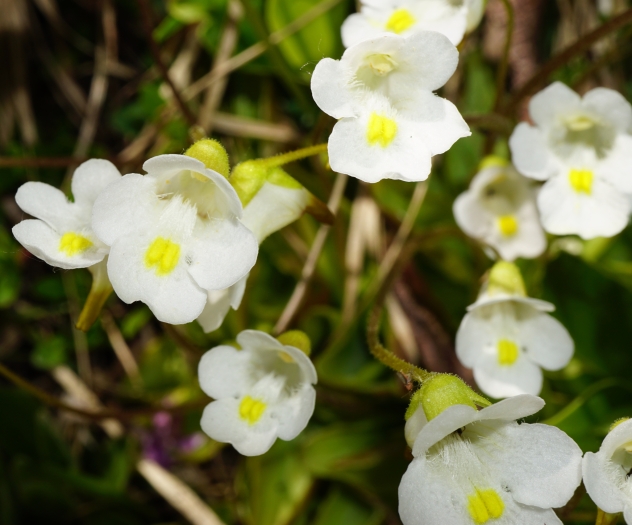Alpine Butterwort
(Pinguicula alpina)
Alpine Butterwort (Pinguicula alpina)
/
/

Patrick Hacker
CC BY 4.0
Image By:
Patrick Hacker
Recorded By:
Copyright:
CC BY 4.0
Copyright Notice:
Photo by: Patrick Hacker | License Type: CC BY 4.0 | License URL: http://creativecommons.org/licenses/by/4.0/ | Rights Holder: Patrick Hacker | Publisher: iNaturalist | Date Created: 2021-06-15T13:49:52-07:00 |

























Estimated Native Range
Summary
Pinguicula alpina, commonly known as alpine butterwort, is a carnivorous perennial herb that thrives in the harsh conditions of high latitudes and altitudes throughout Eurasia, including regions from Iceland to the Himalayas. Alpine butterwort typically reaches a modest height of 2-6 inches and is adapted to wet, nutrient-poor, acidic soils found in subalpine seeps, bogs, and alpine meadows. The plant is characterized by a prostrate rosette of succulent leaves that are green to red in color, which secrete a sticky mucilage to trap and digest small insects, providing essential nutrients in its nutrient-deficient environment.
Alpine butterwort is valued for its unique insectivorous habit and delicate white flowers with yellow markings that bloom from May to August, adding interest to rock gardens, bog gardens, and terrariums. It is relatively low maintenance, requiring consistently moist soil and cool conditions to thrive. While it is not commonly afflicted by diseases, it can be sensitive to overly rich or dry soils. Alpine butterwort is not known for being invasive and poses little threat to native ecosystems when grown outside its native range. It is a fascinating example of plant adaptation and survival in challenging environments.CC BY-SA 4.0
Alpine butterwort is valued for its unique insectivorous habit and delicate white flowers with yellow markings that bloom from May to August, adding interest to rock gardens, bog gardens, and terrariums. It is relatively low maintenance, requiring consistently moist soil and cool conditions to thrive. While it is not commonly afflicted by diseases, it can be sensitive to overly rich or dry soils. Alpine butterwort is not known for being invasive and poses little threat to native ecosystems when grown outside its native range. It is a fascinating example of plant adaptation and survival in challenging environments.CC BY-SA 4.0
Plant Description
- Plant Type: Herb
- Height: 0.1-0.3 feet
- Width: 0.1-0.2 feet
- Growth Rate: Slow
- Flower Color: White
- Flowering Season: Summer
- Leaf Retention: Deciduous
Growth Requirements
- Sun: Full Sun, Part Shade
- Water: Medium
- Drainage: Medium
Common Uses
Butterfly Garden, Deer Resistant, Low Maintenance, Potted Plant, Water Garden
Natural Habitat
Native to subalpine seeps, bogs, and alpine meadows throughout Eurasia, from Iceland to the Himalayas
Other Names
Common Names: White-flowered Butterwort
Scientific Names: , Pinguicula alpina, Pinguicula alba, Pinguicula alba, Pinguicula albiflora, Pinguicula albiflora var. villosa, Pinguicula alpestris, Pinguicula alpina, Pinguicula alpina, Pinguicula alpina
GBIF Accepted Name: